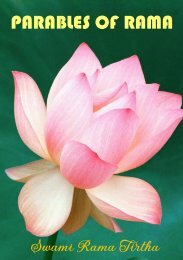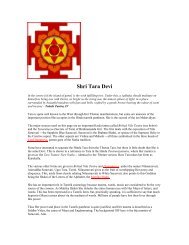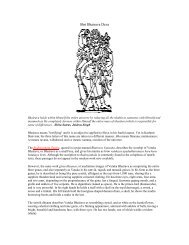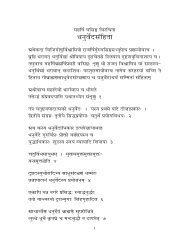Create successful ePaper yourself
Turn your PDF publications into a flip-book with our unique Google optimized e-Paper software.
10.10. Children of a Brahmana by (women of) the three (lower) castes, of a Kshatriya by (wives of) the two<br />
(lower) castes, and of a Vaisya by (a wife of) the one caste (below him) are all six called base-born (apasada).<br />
@L¥\DG{ LY¾N1\D\D V8WDH YLW MDLWW! Y(=\DQ PDJ[ Y(GHKD( UDM LY¾ $šQDVXWD(<br />
10.11. From a Kshatriya by the daughter of a Brahmana is born (a son called) according to his caste (gati) a<br />
Suta; from a Vaisya by females of the royal and the Brahmana (castes) spring a Magadha and a Vaideha.<br />
]8²DG{ $D\DHJY! @¢D F^IDO] F $[PDH Q>DP Y(=\ UDM1\ LY¾DVX MD\1WH Y>5VNUD!<br />
10.12. From a Sudra are born an Ayogava, a Kshattri, and a Kandala, the lowest of men, by Vaisya, Kshatriya,<br />
and Brahmana) females, (sons who owe their origin to) a confusion of the castes.<br />
#ND1WUH 7Y $DQXODH0\DG{ $0EÑ €D( \ZD 6PWD( @¢ Y(GHKND( W´W ¾DLWODH0\H $LS M1PLQ<br />
10.13. As an Ambashtha and an Ugra, (begotten) in the direct order on (women) one degree lower (than their<br />
husbands) are declared (to be), even so are a Kshattri and a Vaidehaka, though they were born in the inverse<br />
order of the castes (from mothers one degree higher than the fathers).<br />
SX¥D \H $Q1WUÒ,MD! ‘PH> ‹D L´M1PQDP WDQ $Q1WU QDÅV WX PDWGDH DW ¾F@WH<br />
10.14. Those sons of the twice-born, begotten on wives of the next lower castes, who have been enumerated in<br />
due order, they call by the name Anantaras (belonging to the next lower caste), on account of the blemish<br />
(inherent) in their mothers.<br />
ÂDÚ>DG{ €N1\D\DP $DYWDH QDP MD\WH $D ,UDH $0EÑN1\D\DP $D\DHJ9\D WX L[*Y>!<br />
10.15. A Brahmana begets on the daughter of an Ugra an Avrita, on the daughter of an Ambashtha an Abhira,<br />
but on a female of the Ayogava (caste) a Dhigvana.<br />
$D\DHJY] F @¢D F F^IDO] F $[PDH Q>DP ¾DLWODH0\HQ MD\1WH ]8²DG{ $SVGDV ¥\!<br />
10.16. From a Sudra spring in the inverse order (by females of the higher castes) three base-born (sons,<br />
apasada), an Ayogava, a Kshattri, and a Kandala, the lowest of men;<br />
Y(=\DQ PDJ[ Y(GHKD( @L¥\DW V8W #Y WX ¾W,SP #WH MD\1WH SUH $3\SVGDV ¥\!<br />
10.17. From a Vaisya are born in the inverse order of the castes a Magadha and a Vaideha, but from a Kshatriya<br />
a Suta only; these are three other base-born ones (apasada).<br />
MDWDH LQ DGDW ]8²D\D MD7\D YLW SXjV! ]8²DM MDWDH LQ D D WX V Y( NejeTN! 6PW!<br />
10.18. The son of a Nishada by a Sudra female becomes a Pukkasa by caste (gati), but the son of a Sudra by a<br />
Nishada female is declared to be a Kukkutaka.<br />
@¢XU{ MDWV WZD €D\D ÏSDN LW N,7\5WH Y(GHKNHQ 7Y $0EÑ DP 7S¸DH YH> &\WH<br />
10.19. Moreover, the son of by Kshattri by an Ugra female is called a Svapaka; but one begotten by a<br />
Vaidehaka on an Ambashtha female is named a Vena.<br />
L´MDW\! VY>D5VX MQ\17\ÊWDV WX \DQ WDQ VDLY¥,SLUÄÐDQ ÊD7\DQ LW LYLQLG5]HW






![[ Home ] [ Up ] Books Contact us Immortal Promise ... - Hindu Online](https://img.yumpu.com/9577792/1/190x245/-home-up-books-contact-us-immortal-promise-hindu-online.jpg?quality=85)

